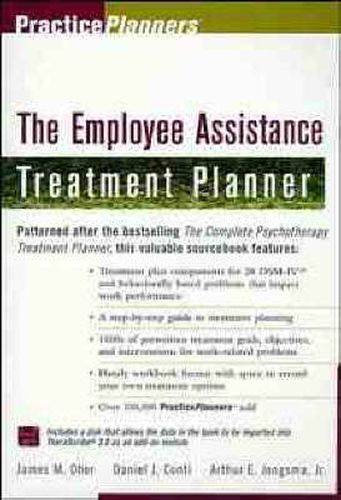Readings Newsletter
Become a Readings Member to make your shopping experience even easier.
Sign in or sign up for free!
You’re not far away from qualifying for FREE standard shipping within Australia
You’ve qualified for FREE standard shipping within Australia
The cart is loading…






Treatment plan components for 28 DSM-IVTM and behaviorally based problems that impact work performance. A step-by-step guide to treatment planning 1000s of prewritten treatment goals, objectives, and interventions for work-related problems. Handy workbook format with space to record your own treatment options Over 100,000 PracticePlanners™ sold Saves you hours of painstaking paperwork while offering optimum latitude in developing customized treatment plans for most problems encountered in employee assistance programs. This valuable sourcebook supplies EAP counselors and mental health clinicians who work with employee assistance programs with all of the essential building blocks they need to quickly create focused, formal treatment plans that fully satisfy the demands of third-party payers, accrediting agencies, and state and federal review agencies. Following the same format as the bestselling The Complete Psychotherapy Treatment Planner, it is organized around 28 major presenting problems encountered in employee assistance programs, including chemical dependence, low self-esteem, career burnout, job loss, and more. Practical, progressive, and focused on problem-resolution, The Employee Assistance Treatment Planner features: 1,000s of well-crafted statements to choose from, describing behavioral manifestations, long- and short-term goals, and treatment options A sample plan that can be emulated in writing plans that meet all requirements of third-party payers and accrediting agencies, including the JCAHO A presenting problem list, including all relevant DSM-IV™ categories A quick-reference format that lets you locate treatment plan components by behavioral problem or DSM-IV diagnosis Large workbook-style pages affording plenty of space to record your own customized goals, objectives, and interventions.
$9.00 standard shipping within Australia
FREE standard shipping within Australia for orders over $100.00
Express & International shipping calculated at checkout
Treatment plan components for 28 DSM-IVTM and behaviorally based problems that impact work performance. A step-by-step guide to treatment planning 1000s of prewritten treatment goals, objectives, and interventions for work-related problems. Handy workbook format with space to record your own treatment options Over 100,000 PracticePlanners™ sold Saves you hours of painstaking paperwork while offering optimum latitude in developing customized treatment plans for most problems encountered in employee assistance programs. This valuable sourcebook supplies EAP counselors and mental health clinicians who work with employee assistance programs with all of the essential building blocks they need to quickly create focused, formal treatment plans that fully satisfy the demands of third-party payers, accrediting agencies, and state and federal review agencies. Following the same format as the bestselling The Complete Psychotherapy Treatment Planner, it is organized around 28 major presenting problems encountered in employee assistance programs, including chemical dependence, low self-esteem, career burnout, job loss, and more. Practical, progressive, and focused on problem-resolution, The Employee Assistance Treatment Planner features: 1,000s of well-crafted statements to choose from, describing behavioral manifestations, long- and short-term goals, and treatment options A sample plan that can be emulated in writing plans that meet all requirements of third-party payers and accrediting agencies, including the JCAHO A presenting problem list, including all relevant DSM-IV™ categories A quick-reference format that lets you locate treatment plan components by behavioral problem or DSM-IV diagnosis Large workbook-style pages affording plenty of space to record your own customized goals, objectives, and interventions.